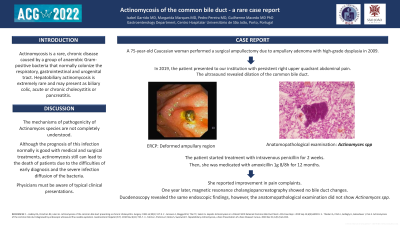Back


Poster Session A - Sunday Afternoon
Category: Biliary/Pancreas
A0049 - Actinomycosis of the Common Bile Duct: A Rare Case Report
Sunday, October 23, 2022
5:00 PM – 7:00 PM ET
Location: Crown Ballroom

Has Audio
- IG
Isabel Garrido, MD
Centro Hospitalar Universitário de São João
Porto, Porto, Portugal
Presenting Author(s)
Isabel Garrido, MD1, Margarida Marques, MD1, Pedro Pereira, 2, Guilherme Macedo, MD, PhD3
1Centro Hospitalar Universitário de São João, Porto, Porto, Portugal; 2Centro Hospitalar de São João, Porto, Porto, Portugal; 3Centro Hospitalar de S. João, Porto, Porto, Portugal
Introduction: Actinomycosis is a rare, chronic disease caused by a group of anaerobic Gram-positive bacteria that normally colonize the respiratory, gastrointestinal and urogenital tract. Its incidence has diminished globally due to improved oral hygiene and the development of antibiotics. Multiple different clinical features of actinomycosis have been described, as various anatomical sites can be affected. Hepatobiliary actinomycosis is extremely rare and may present as biliary colic, acute or chronic cholecystitis or pancreatitis.
Case Description/Methods: A 75-year-old Caucasian woman performed a surgical ampullectomy due to ampullary adenoma with high-grade dysplasia in 2009. Nine years later, esophagogastroduodenoscopy revealed growth of adenomatous tissue in the same location. Mucosectomy was performed, without complications. Histological examination revealed a tubulovillous adenoma with low-grade dysplasia. In 2019, the patient presented to our institution with persistent right upper quadrant abdominal pain. The ultrasound revealed dilation of the common bile duct. Endoscopic retrograde cholangiopancreatography was performed and showed a deformed ampullary region, but without apparent residual lesion. Biopsies were performed, which revealed fragments of duodenal mucosa with abundant inflammatory infiltrate and identification of colonies of microorganisms with characteristics compatible with Actinomyces spp. The patient started treatment with intravenous penicillin for 2 weeks. Subsequently, she was medicated with amoxicillin 1g 8/8h for 12 months. She reported improvement in pain complaints. One year later, magnetic resonance cholangiopancreatography showed no bile duct changes. Duodenoscopy revealed the same endoscopic findings, however, the anatomopathological examination showed nonspecific chronic inflammatory changes without isolation of Actinomyces spp.
Discussion: The mechanisms of pathogenicity of Actinomyces species are not completely understood, but the invasion of breached or necrotic tissue has been proposed to be the initiating event for Actinomyces to penetrate and proliferate in deeper body structures. Although the prognosis of this infection normally is good with medical and surgical treatments, actinomycosis still can lead to the death of patients due to the difficulties of early diagnosis and the severe infection diffusion of the bacteria. Therefore, physicians must be aware of typical clinical presentations.
Disclosures:
Isabel Garrido, MD1, Margarida Marques, MD1, Pedro Pereira, 2, Guilherme Macedo, MD, PhD3. A0049 - Actinomycosis of the Common Bile Duct: A Rare Case Report, ACG 2022 Annual Scientific Meeting Abstracts. Charlotte, NC: American College of Gastroenterology.
1Centro Hospitalar Universitário de São João, Porto, Porto, Portugal; 2Centro Hospitalar de São João, Porto, Porto, Portugal; 3Centro Hospitalar de S. João, Porto, Porto, Portugal
Introduction: Actinomycosis is a rare, chronic disease caused by a group of anaerobic Gram-positive bacteria that normally colonize the respiratory, gastrointestinal and urogenital tract. Its incidence has diminished globally due to improved oral hygiene and the development of antibiotics. Multiple different clinical features of actinomycosis have been described, as various anatomical sites can be affected. Hepatobiliary actinomycosis is extremely rare and may present as biliary colic, acute or chronic cholecystitis or pancreatitis.
Case Description/Methods: A 75-year-old Caucasian woman performed a surgical ampullectomy due to ampullary adenoma with high-grade dysplasia in 2009. Nine years later, esophagogastroduodenoscopy revealed growth of adenomatous tissue in the same location. Mucosectomy was performed, without complications. Histological examination revealed a tubulovillous adenoma with low-grade dysplasia. In 2019, the patient presented to our institution with persistent right upper quadrant abdominal pain. The ultrasound revealed dilation of the common bile duct. Endoscopic retrograde cholangiopancreatography was performed and showed a deformed ampullary region, but without apparent residual lesion. Biopsies were performed, which revealed fragments of duodenal mucosa with abundant inflammatory infiltrate and identification of colonies of microorganisms with characteristics compatible with Actinomyces spp. The patient started treatment with intravenous penicillin for 2 weeks. Subsequently, she was medicated with amoxicillin 1g 8/8h for 12 months. She reported improvement in pain complaints. One year later, magnetic resonance cholangiopancreatography showed no bile duct changes. Duodenoscopy revealed the same endoscopic findings, however, the anatomopathological examination showed nonspecific chronic inflammatory changes without isolation of Actinomyces spp.
Discussion: The mechanisms of pathogenicity of Actinomyces species are not completely understood, but the invasion of breached or necrotic tissue has been proposed to be the initiating event for Actinomyces to penetrate and proliferate in deeper body structures. Although the prognosis of this infection normally is good with medical and surgical treatments, actinomycosis still can lead to the death of patients due to the difficulties of early diagnosis and the severe infection diffusion of the bacteria. Therefore, physicians must be aware of typical clinical presentations.
Disclosures:
Isabel Garrido indicated no relevant financial relationships.
Margarida Marques indicated no relevant financial relationships.
Pedro Pereira indicated no relevant financial relationships.
Guilherme Macedo indicated no relevant financial relationships.
Isabel Garrido, MD1, Margarida Marques, MD1, Pedro Pereira, 2, Guilherme Macedo, MD, PhD3. A0049 - Actinomycosis of the Common Bile Duct: A Rare Case Report, ACG 2022 Annual Scientific Meeting Abstracts. Charlotte, NC: American College of Gastroenterology.
